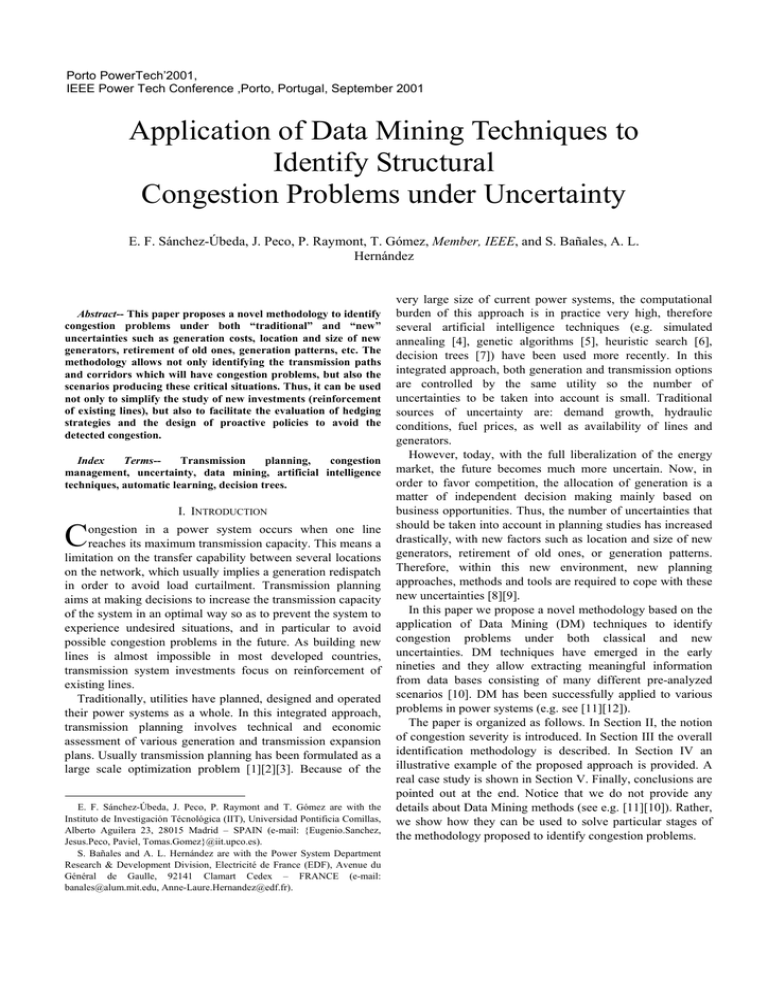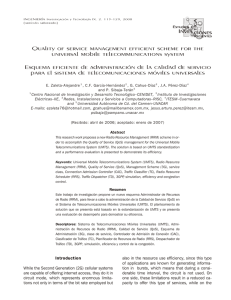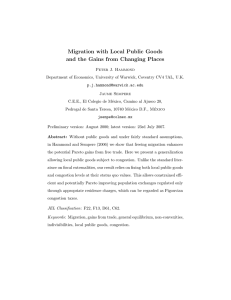as a PDF
Anuncio

Porto PowerTech’2001,
IEEE Power Tech Conference ,Porto, Portugal, September 2001
Application of Data Mining Techniques to
Identify Structural
Congestion Problems under Uncertainty
E. F. Sánchez-Úbeda, J. Peco, P. Raymont, T. Gómez, Member, IEEE, and S. Bañales, A. L.
Hernández
Abstract-- This paper proposes a novel methodology to identify
congestion problems under both “traditional” and “new”
uncertainties such as generation costs, location and size of new
generators, retirement of old ones, generation patterns, etc. The
methodology allows not only identifying the transmission paths
and corridors which will have congestion problems, but also the
scenarios producing these critical situations. Thus, it can be used
not only to simplify the study of new investments (reinforcement
of existing lines), but also to facilitate the evaluation of hedging
strategies and the design of proactive policies to avoid the
detected congestion.
Index
Terms-Transmission
planning,
congestion
management, uncertainty, data mining, artificial intelligence
techniques, automatic learning, decision trees.
I. INTRODUCTION
C
ongestion in a power system occurs when one line
reaches its maximum transmission capacity. This means a
limitation on the transfer capability between several locations
on the network, which usually implies a generation redispatch
in order to avoid load curtailment. Transmission planning
aims at making decisions to increase the transmission capacity
of the system in an optimal way so as to prevent the system to
experience undesired situations, and in particular to avoid
possible congestion problems in the future. As building new
lines is almost impossible in most developed countries,
transmission system investments focus on reinforcement of
existing lines.
Traditionally, utilities have planned, designed and operated
their power systems as a whole. In this integrated approach,
transmission planning involves technical and economic
assessment of various generation and transmission expansion
plans. Usually transmission planning has been formulated as a
large scale optimization problem [1][2][3]. Because of the
E. F. Sánchez-Úbeda, J. Peco, P. Raymont and T. Gómez are with the
Instituto de Investigación Técnológica (IIT), Universidad Pontificia Comillas,
Alberto Aguilera 23, 28015 Madrid – SPAIN (e-mail: {Eugenio.Sanchez,
Jesus.Peco, Paviel, Tomas.Gomez}@iit.upco.es).
S. Bañales and A. L. Hernández are with the Power System Department
Research & Development Division, Electricité de France (EDF), Avenue du
Général de Gaulle, 92141 Clamart Cedex – FRANCE (e-mail:
banales@alum.mit.edu, Anne-Laure.Hernandez@edf.fr).
very large size of current power systems, the computational
burden of this approach is in practice very high, therefore
several artificial intelligence techniques (e.g. simulated
annealing [4], genetic algorithms [5], heuristic search [6],
decision trees [7]) have been used more recently. In this
integrated approach, both generation and transmission options
are controlled by the same utility so the number of
uncertainties to be taken into account is small. Traditional
sources of uncertainty are: demand growth, hydraulic
conditions, fuel prices, as well as availability of lines and
generators.
However, today, with the full liberalization of the energy
market, the future becomes much more uncertain. Now, in
order to favor competition, the allocation of generation is a
matter of independent decision making mainly based on
business opportunities. Thus, the number of uncertainties that
should be taken into account in planning studies has increased
drastically, with new factors such as location and size of new
generators, retirement of old ones, or generation patterns.
Therefore, within this new environment, new planning
approaches, methods and tools are required to cope with these
new uncertainties [8][9].
In this paper we propose a novel methodology based on the
application of Data Mining (DM) techniques to identify
congestion problems under both classical and new
uncertainties. DM techniques have emerged in the early
nineties and they allow extracting meaningful information
from data bases consisting of many different pre-analyzed
scenarios [10]. DM has been successfully applied to various
problems in power systems (e.g. see [11][12]).
The paper is organized as follows. In Section II, the notion
of congestion severity is introduced. In Section III the overall
identification methodology is described. In Section IV an
illustrative example of the proposed approach is provided. A
real case study is shown in Section V. Finally, conclusions are
pointed out at the end. Notice that we do not provide any
details about Data Mining methods (see e.g. [11][10]). Rather,
we show how they can be used to solve particular stages of
the methodology proposed to identify congestion problems.
II. NOTION OF CONGESTION SEVERITY
III. IDENTIFICATION METHODOLOGY
Two key issues arise when studying a particular scenario:
(i) Is there a congestion?, and (ii) If so, how important is it?.
To answer both questions, we propose appropriate congestion
indicators as well as two types of numerical simulations.
The proposed identification methodology consists of two
main steps (Fig. 1): (i) data base generation of possible
scenarios, and (ii) data base analysis using data mining
techniques. This approach can be repeated several times as our
knowledge about the congestion problem increases.
A. Congestion indicators
The congestion indicators can be used to identify
congestion problems in a particular scenario as well as to
assess their severity.
Two types of indicators can be used: local and global
congestion indicators. The first ones provide information
about the congestion of a particular line. However, sometimes
an index of the global congestion of the network can be
useful. The global congestion indicators summarize the local
congestion problems into a more general index. Using these
global indicators a network situation can be directly classified
according to “its severity” in terms of congestion problems.
Some of the proposed local congestion indicators are:
Power flow/ transmission capacity Ratio (F/C), OPF dual
variable associated with the transmission capacity of a line,
non supplied energy of a bus, etc.
Concerning global congestion indicators, we propose: Mean
squared power flow / transmission capacity Ratio, difference
between total dispatch costs with and without power flows
constraints (redispatch costs, RC), Number of redispatched
generators, Total redispatched generation, etc. In the
illustrative example we have used the RC indicator because it
provides directly an economic assessment of the congestion
problems.
B. Types of numerical simulations
At first, a DC non-linear optimal dispatch without
constraints on power flows will provide a first diagnosis of the
situation, telling us if there are overloaded lines or not.
Unfortunately, the results of this first simulation do not assess
the severity of the congestion accurately. For example, a
scenario with a heavily overloaded line could be less severe
than other scenario with other lines being only slightly
overloaded because, in the first case, the economic impact
associated with the generation redispatch needed to solve the
congestion could be much smaller than in the second situation.
A second analysis, consisting in a DC non-linear optimal
dispatch with transmission constraints will allow determining
the congestion severity in terms of its economic impact more
accurately.
Notice that in transmission planning studies, several
scenarios have to be considered. For example, when studying
a new investment, the resultant network should perform
successfully under every plausible scenario. Thus, the severity
of a particular congestion depends not only on the analysis of
an scenario but also on its importance. This importance is
related to both its probability and its impact on the network.
2
Scenarios
Builder
3
Network
model
OPF
results
Simulator
Scenario
Scenario
Scenario
Primal & dual variables
(Power flows, spot prices, ...)
Data Base
Exogenous
variable
distributions
1
Study Definition
4
Data mining
Fig. 1. Identification methodology
A. Definition of the range of possible situations
Uncertainties will be modeled as probability distributions.
These distributions can be discrete or continuous, depending
on the nature of the variable. The different network situations
(scenarios) will be generated by sampling these distributions.
This probabilistic model is flexible enough to reflect the
intrinsic probabilistic nature of the uncertainties to be modeled
(availability of lines and generators, hydraulic conditions,
generation costs, location and size of new generators,
retirement of old ones, etc). For example, for a given bus one
can set a distribution for a given technology describing the
probability of having zero, one or two units.
This probabilistic model should incorporate all prior
knowledge as well as the definition of the range of conditions
which the study aims to cover. As the size of the network
increases, both the number of possible scenarios and the
computational requirements to simulate them grow
exponentially. Thus, in order to deal with this curse-ofdimensionality, the probability distributions of rare events
with a significant impact (e.g. the failure of a nuclear unit) are
biased to ensure that they will be sampled.
B. Generation and simulation of scenarios
The objective of this stage is to obtain a sufficiently rich
data base (DB), which both contains plausible operating states
and covers all relevant congested situations. These scenarios
are randomly drawn from previous probability distributions.
According to previous section, each scenario is simulated
using a DC non-linear optimal dispatch with and without
transmission constraints. All in all, from each scenario we
save in the DB a set of parameters or attributes characterizing
it. These attributes are mainly installed capacities of
generators (by type and bus) and generation costs, together
with congestion indicators.
C. Analysis using Data Mining Techniques
Traditionally, utilities have planned, designed and operated
their power systems as a whole. In this integrated approach,
sources of uncertainty were small and well known. Typically,
with 20 scenarios all relevant situations were captured and the
planer knew how to run the network under these
circumstances.
However, today, with the full liberalization of the energy
market, the future becomes much more uncertain as both the
allocation of generation is a matter of independent decision
making and bilateral contracts between agents from different
countries may change the traditional power flow patterns.
Under this new situation, the number of scenarios is huge and
previous knowledge about the network behavior is not enough
to identify the possible congestion problems, their severity
and their root causes.
Data mining techniques allow dealing with this new
situation (see e.g. [10][13]). In particular, these techniques are
able to identify the possible congestion problems, their
severity and their root causes by analyzing huge amounts of
simulated scenarios in a systematic way. We have used a set
of techniques, including decision and regression trees
[11][10], clustering techniques and ORTHO models (e.g. see
[14]).
The proposed approach is depicted in Fig. 2. After defining
the network model and the considered uncertainties, a large
set of scenarios are generated and analyzed using data mining
techniques.
These techniques rely on the selection of suitable candidate
attributes that are able to explain the root causes of network
congestion. This topic is especially relevant when dealing
with real sized networks, where it is necessary to identify
clusters representing groups of buses (i.e. regions) as well as
groups of lines connecting those regions (i.e. transmission
paths) by finding similarities among physical parameters (see
e.g. [11][15][16][17]). This step is needed to define global
variables related to transmission paths and regions (e.g. the
generation capacity in a region or the number of gas units in a
region) instead of particular lines and buses. Note that these
regions are a key issue as excesses or deficits in the generation
capacity of different areas cause most congestion scenarios.
The next step in our methodology is to perform a global
approach to the congestion problem in order to answer two
questions: (i) what scenarios, among all possible ones, present
congestion problems and why?, and (ii) what are the
congestion modes (i.e. congestion patterns and network
behaviors) and what are the causes of these different modes?.
First, one can get an idea of the possible congestion
problems by building a supervised model such as a decision
tree or an ORTHO model to estimate some global congestion
indicators.
Second, clustering techniques are used to identify
congestion modes (i.e. congestion patterns and network
behaviors), and supervised models to know when these
patterns appear.
Finally, one can focus on particular congestion modes,
congested transmission paths or congested lines by building
supervised model to estimate some local congestion
indicators.
40%
Define study
(network model, uncertainties)
25%
25%
5%
50
5%
100
200
300
600
Generate & simulate
random scenarios
DB
Analysis using Data Mining
Identify regions
(clustering on buses)
Global
knowledge
Global view using global indicators
(histograms, Decision trees, ORTHO)
Identify congestion modes
(clustering on lines, decision trees)
Focus on particular congestion modes
(Decision trees, ORTHO ...)
Particular
knowledge
Focus on particular congested lines
(Decision trees, ORTHO ...)
Fig. 2. Identification methodology (detail)
IV. ILLUSTRATIVE EXAMPLE
In order to illustrate the proposed methodology, we use an
academic network consisting of 11 buses and 14 lines (see
Fig. 3). In each bus the demand is constant (shown in
percentage of the total one), whereas the number of units of
each technology can vary (figure shows the maximum
installed capacity by technology, where: C is coal, H is hydro,
N is nuclear and G is gas). Notice that the number of units
could be related to new generators, retirement of old ones, or
unit availability. The generation costs of nuclear, gas and coal
are drawn from normal distributions N(0.3, 0.025), N(0.55,
0.1) and N(0.6, 0.05), respectively. Finally, two types of
hydraulic conditions (dry and humid) have been taken into
account.
1C
2
1N
1
8C
3
7C
4
2N 4C
13%
5
21%
2C 2H
4N
6
4H
8
1N 10G
28%
7
13%
9
1C 10G
1C 10G
10
10%
11
Region 6
15%
Fig. 3. On-line diagram of the network used for illustration
A large DB consisting of 40000 different scenarios have
been built, where each scenario represents a different network
situation generated by random sampling from the probability
distributions used to model the uncertainties. Each scenario is
described by 67 attributes, corresponding to parameters
describing the electrical state (installed capacities per unit and
technology, generation costs, number of units by technology
and by bus, etc). Using clustering techniques, six regions have
been identified (Fig. 3), e.g. region 6 consists of buses 9, 10
and 11. Note that the total installed capacity of each region
has been also used as an attribute characterizing each scenario.
In order to obtain a first overview, we have built a decision
tree (Fig. 4) to estimate the value of the global congestion
indicator RC. We consider the network has no congestion
problems if RC is zero (label ‘RC=0’), and it has congestion
problems (label ‘RC>0’) otherwise. For example, this decision
tree tells us that if we have enough installed capacity in region
6 (ICReg6>34.5), then the network will be clearly congested
if coal is cheaper than gas (costC-costG<-0.03), see node A in
Fig. 4. To evaluate the generalization capability of these
decision trees, they were tested on the basis of an independent
test set of 8000 scenarios (i.e. not used for building the trees),
yielding an overall error rate of 14.3% (i.e. 85.7% of correct
classifications)
Fig. 5. Decision tree for the congestion of line 3-8
Furthermore, it is possible to estimate the exact value of
F/C of line 3-8 by means of the ORTHO model (Fig. 4). This
model provides us the sensitivity of the output with the
different relevant input variables. For example, this model tell
us that if the installed capacity of region 6 is large enough
(ICReg6>47) then we can not decrease the power flow of line
3-8 by increasing the installed capacity of this region, which is
physically sound. According to this model, higher hydraulic
capacity in bus 7 (ICBus7) leads to lower power flows in line
3-8. On the other hand, this flow decreases when the
availability of nuclear units in bus 8 (NUBus8) increases.
IMP:1.000 (K=5)
IMP:0.855 (K=2)
0.8
0.8
data
LHM
0.6
0.4
0.4
0.2
0.2
0
0
−0.2
−0.2
−0.4
−0.4
0
10
20
30
ICBus7(1*h−4*h)
40
data
LHM
0.6
50
1
2
3
NUBus8(1−4)
IMP:0.541 (K=4)
IMP:0.368 (K=6)
0.8
data
LHM
0.6
Fig. 4. Decision tree for the global congestion indicator RC
After extracting global knowledge about the congestion
problems of the network, we can study separately the
congestion of each line. Lines 8-9, 5-9, 3-8, 7-10 and 9-11
have congestion problems. For example, Fig. 5 shows a
decision tree to estimate if line 3-8 is congested or not. We
consider it is non-congested if the local congestion indicator
F/C of line 3-8 is smaller or equal than 1 (N), congested (C)
otherwise. For example, this tree tell us that line 3-8 is
congested when the number of nuclear units of bus 8 is not
maximum (NUBus8<3.5), the scenario is dry (ICBus8<30)
and the total number of nuclear units is less than 6.5. This tree
yields an overall error rate of 4.24% in the same test set (i.e.
95.76% of correct classifications). Note that better decision
trees, in terms of accuracy, can be obtained by allowing the
expansion of some nodes.
4
0.8
0.4
0.4
0.2
0.2
0
0
−0.2
−0.2
−0.4
data
LHM
0.6
−0.4
0
10
20
30
ICReg6(3−50)
40
50
−0.2
−0.1
0
0.1
costC−costG
0.2
0.3
Fig. 6. ORTHO model for the local indicator F/C of line 3-8
V.REAL STUDY
The proposed methodology has also been tested on a realistic
problem. In particular we have used a detailed model of the
real Spanish network consisting of 1140 nodes, 1500 lines and
225 installed generators. It also includes interconnections with
France, Portugal and Morocco. There are 5 different
technologies: Coal, hydro, nuclear, and gas.
Several uncertainties has been taken into account: the
unavailability of 5 main nuclear units, the possibility of 19
new gas plants comprising a number of units drawn from the
uniform distribution U(0, 3); different generation costs of coal
and gas technologies, see Fig. 7. Finally, two types of
hydraulic conditions (dry and humid) have been taken into
account.
50%
Nuclear
and Coal
Line L
Reg11
1082
775
Hydro
Coal cost
50%
Gas cost
Fig. 9. On-line diagram of the real case network (simplified)
35%
25%
25%
15%
0.5
0.6
Generation cost
0.7
Fig. 7. Distribution for the generation costs of coal and gas technologies
A DB consisting of 6000 scenarios have been built by
random sampling from previous probability distributions. In
this case each scenario is described by 146 attributes,
corresponding to parameters describing the electrical state (see
Appendix). Note that this set of attributes also includes more
general parameters summarizing the information of different
regions (in this study 20 independent regions have been
identified).
The obtained models are simple, accurate and physically
sound, providing physical understanding of the particular
congestion problem. For example, Fig. 8 shows a decision tree
to estimate if a line L is congested or not. We consider it is
non-congested if the local congestion indicator F/C of line L is
smaller or equal than 1 (N), congested (C) otherwise.
According to this model, this line is congested in the next
three cases (Fig. 9): (i) when there are no gas units in Bus
1082 (GUBus1082<0.5) and it is a dry scenario; (ii) when
there are no gas units in Bus 1082, the scenario is humid
(Hcoef<0.92) and there is not enough installed capacity in
region 11, and; (iii) when there are no gas units in Bus 1082,
the scenario is humid, there is enough installed capacity in
region 11 (ICReg11<17.65), but there are no gas units in Bus
775 (GUBus775<0.5).
VI. CONCLUSIONS
In this paper we have proposed a methodology to identify
congestion problems under both “traditional” and “new”
uncertainties such as uncertainty about generation costs,
location and size of new generators, retirement of old ones,
generation patterns, etc. The methodology allows not only
identifying the transmission paths and corridors which will
have congestion problems, but also the scenarios producing
these critical situations. Thus, it can be used not only to
simplify the study of new investments (reinforcement of
existing lines), but also to facilitate the evaluation of hedging
strategies and the design of proactive policies to avoid the
detected congestion.
Concerning future work, we are extending the proposed
methodology to assess the economic impact of a congestion
problem. This last step is required to propose and evaluate
alternative investment plans.
VII. APPENDIX - CANDIDATE ATTRIBUTES
Here we provide a brief list of possible candidate attributes
that has been used in our studies.
-
Installed capacities per unit and by technology
Generation costs by technology
Number of units by technology and by bus
The difference of cost between technologies
The total installed capacity by technology
The total installed capacity by bus
The cheapest technology by bus
The most expensive technology by bus
The global installed capacity by technology
The total installed capacity by region
The total installed capacity by region and by technology
Hydraulic conditions
VIII. REFERENCES
[1]
[2]
[3]
[4]
Fig. 8. Decision tree for the congestion of line L (real case study)
L. 1. Garver, R. Villasana, S. J. Salon, “Transmission Network Planning
Using Linear Programming,” IEEE Trans. on PAS, vol 104, No. 2, Feb.
1985.
V. Levi, M. S. Calovic, “A New Decomposition Based Method for
Optimal Expansion Planning of Large Transmission Networks,” IEEE
Trans. on Power Systems, vol 6, No. 3, August 1991.
R. Romero, A. Monticelli, “A Hierarchical Decomposition Approach for
Transmission Network Expansion Planning,” IEEE Trans. on Power
Systems, vol 9, No. 1, Feb. 1994.
R. Romero, R. A. Gallego, A. Monticelli, “Transmission System
Expansion Planning by Simmulated Annealing,” IEEE Trans. on Power
Systems, vol 11, No. 1, Feb. 1996.
[5]
[6]
[7]
[8]
[9]
[10]
[11]
[12]
[13]
[14]
[15]
[16]
[17]
H. Rudnick, R. Palma et al., “Economically Adapted Transmission
Systems in Open Access Schemes- Application of Genetic Algorithms,”
IEEE Trans. on Power Systems, vol 11, No. 3, Aug. 1996.
G. Latorre-Bayona, I. Pérez-Arriaga, “Chopin, a Heuristic Model for
Long Term Transmission Expansion Planning,” IEEE Trans. on Power
Systems, vol 13, No. 2, Feb. 1998.
J. Peco, E. F. Sánchez-Úbeda, T. Gómez, “Enhancing optimal
transmission and subtransmission planning by using decision trees,”
BPT99-304-16, in Proc. IEEE Power Tech, August, 1999.
CIGRE TF 28.05.05, “Techniques for power system planning under
uncertainties,” Cigré report 154, April 2000.
T. de la Torre, J. W. Feltes, T. Gómez, H. Merrill, “Deregulation,
Privatization, and Competition: Transmission Planning under
Uncertainty,” IEEE Trans. on Power Systems, vol 14, No. 2, May 1999.
E. F. Sánchez-Úbeda, “Models for data analysis: contributions to
automatic learning,” Ph.D. dissertation, Univ. Pontificia Comillas, 1999.
L. Wehenkel, Automatic Learning Techniques in Power Systems,
Kluwer Academic, Boston, 1997.
L. Wehenkel, "Machine learning for power system security assessment,”
IEEE Expert, Intelligent Systems and their Applications, vol 12, No. 5,
1997, pp. 60-72.
V. Cherkassky and F. Mulier, Learning from data: concepts, theory, and
methods, John Wiley & Sons, New York, 1998.
E. F. Sánchez-Úbeda and L. Wehenkel, "Automatic fuzzy-rules
induction by using the ORTHO model,” in Proc. IPMU'2000, July 2000.
T. Kohonen, Self-Organizing Maps, Springer Verlag Series in
Information Sciences, vol. 30, 1995.
R. O. Duda and P. E. Hart, Pattern classification and scene analysis,
John Wiley and Sons, 1973.
L. Kaufman and P. J. Rousseuw, Finding Groups in Data, John Wiley &
Sons, 1990.
IX. BIOGRAPHIES
Eugenio Francisco Sánchez Úbeda received
the Electronic Engineering Degree in 1991 and the
Ph.D. Degree in 1999, both from the Universidad
Pontificia Comillas. He is presently a research
fellow and co-ordinator of the Intelligent Systems
Group of the ‘Instituto de Investigación
Tecnológica’ and teaches a course on “Advanced
data analysis” and on “Sorting and searching
techniques”. Since 1991, he has been working in
the field of artificial intelligence and its
applications.
Jesús Pascual Peco González was born in Las
Palmas, Spain, in 1972. He obtained his Electrical
Engineering Degree in the Pontificia Comillas
University of Madrid in 1996. He joined the
‘Instituto de Investigación Tecnológica’ at the
Pontificia Comillas University in 1996, where he is
currently finishing his PhD thesis on distribution
planning models. He has carried out several
researches in the areas of distribution planning,
distribution regulation, reliability and optimization
techniques.
Tomás Gómez San Román obtained his
Electrical Engineering Degree in the Pontificia
Comillas University, Madrid, in 1982, and his
Ph.D. Degree in the Polytechnic University of
Madrid, in 1989. He is a research fellow, and has
been the director of the ‘Instituto de Investigación
Tecnológica’ since 1994. He has been involved in
more than thirty research projects with Spanish
and European utilities. His areas of interest are: the
planning and operation of transmission and
distribution systems, power quality and regulatory issues.
Paviel Raymont obtained the Civil Engineering degree from the "Ecole
des Mines de Nancy" (France) in 1999. He is currently working for Electricité
de France (EDF), and sent in the Instituto de Investigación Tecnológica (IIT),
to work on the project concerning network planning with uncertainty in a
deregulated environment. His areas of interest are related to numerical
simulation, power systems and management of industrial systems.
Santiago Bañales López holds a Master of Science (1998) in Technology
and Policy from the Massachusetts Institute of Technology and a dual
Engineering degree from the Escuela Técnica superior de Ingenieros
Industriales de Madrid and from Ecole Centrale Paris (1994). He has been
Researcher at the Power Systems Department of the Electricité de France
Research and Development Division until December 2000, where he
specialized on transmission planning and pricing issues under open access.
Currently he is part of the Utilities practice of A.T. Kearney, a management
consulting firm.
Anne-Laure Hernández graduated from the “Ecole Nationale Supérieure
des Mines de Paris” (ENSMP) in 1993. She joined the R&D division of EDF
in 1994, where she first worked with the Electricity Uses Department. Since
1998, she works with the Power System Department at EDF-R&D, where she
is mainly involved in Transmission System development.






